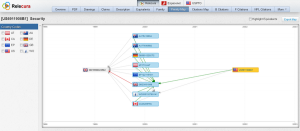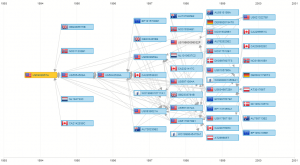Technology usually advances with incremental improvements, and analyzing patent filings can be a good way to understand this. Find out how you can plot patent family members on a map, to easily comprehend their connections as well as the evolution of that technology for specific or related patent filings.
Typically, if you have one patent application in the US (to take an example), you can claim the priority of this application to apply to a patent in other countries, usually within 12 months. This would be a straightforward scenario though.
What if the situation were a little more complex? In majority of the cases, there would be multiple interconnected family documents (both in the same geography as the original filing and in other geographies) claiming priority from several other documents. Now, clearly understanding the connections between several family members might become a bit tedious. This is where the connections get entangled and the resulting web of family documents often seems overwhelming. At Relecura, we’ve tried to simplify this situation.
We’ve come up with a feature namely ‘Priority Maps.’ If you look at the image above closely, you’d notice that the family members of a patent are represented in relation to each other (and arranged in a chronological order). This map includes provisional as well as abandoned applications. And through colored arrows, you can easily comprehend their relationships. As we move the mouse over each document node, the red arrows display connections to the documents from which priority is being claimed, and the green ones display connections to documents claiming priority from the application in question. To drill down, you can click on the document number to view details of that document. Since provisional applications are not published, these are greyed out and do not display any further details.
So, if you were to study the patent US7271194B2 (Oil and gas well cuttings disposal system), the Priority Map for this particular patent would display all family members (as indicated in the image below). Studying such Priority Maps–apart from throwing light on the evolution of an invention and the company’s patenting strategy–may aid in determining Freedom to Operate (FTO) in various geographies. You can now dig deeper into selected documents depending on their positioning on the map. In addition, you can highlight equivalents or specific country codes to study the closely related family members and country specific patents respectively.
The map below displays the extensive geographical coverage of the patent at a single glance. The original patent was granted in the US, but the technology has progressed incrementally over the years. Subsequently, it has gained protection in several European countries as well as Canada and Australia. Consequently, the geographical spread of the family members impacts commercialization potential as well as valuation.
To summarize, this functionality can help you understand patent filing strategies, analyze the geographic reach of a patent, and conduct FTO analysis.












Great, thanks for sharing this blog article.Really looking forward to read more. Fantastic.
Waiting for more posts from this blog.
Thanks for your interest, Anand. There is one coming up next week.
Its a Great Help …!!!
Thank U So Much..!!!